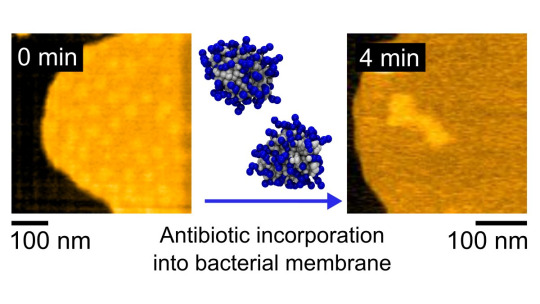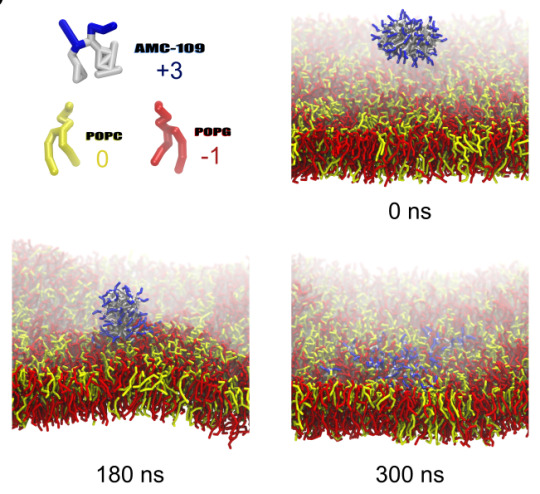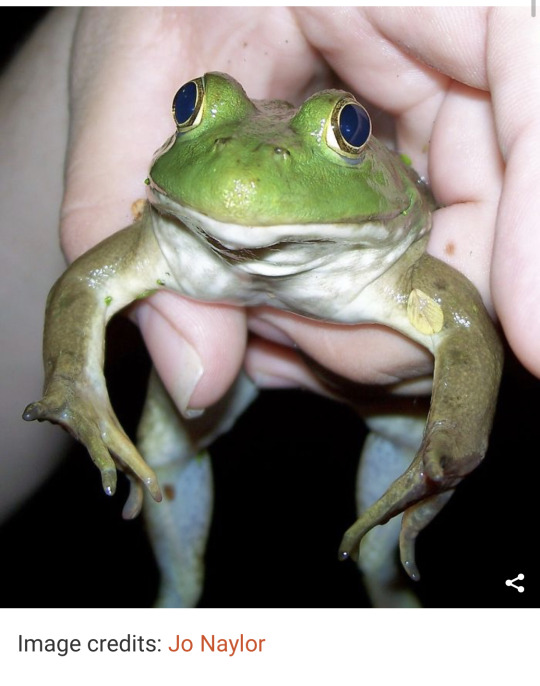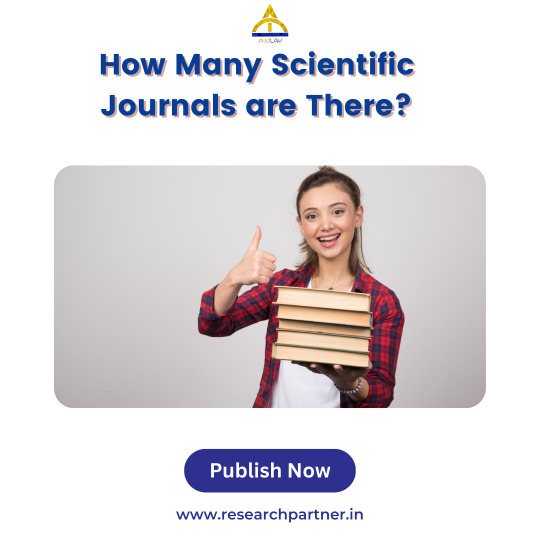#scientific journals
Text
We found a new antibiotic target in bacteria!!
It took almost 4 years, but the fruits of my postdoc research are finally here! In our paper (with me as the first author), just published in Nature Communications, we decipher a working mechanism of an antibiotic that targets the membrane of bacteria in an unprecedented way!
enhanced PDF: https://rdcu.be/dgj2d
web version: https://lnkd.in/eRpxr4jg

And how does it work?
The antibiotic AMC-109 first self-assembles into stable aggregates with a cationic surface. These aggregates then specifically target bacteria cells and insert into their membrane.
You can see the process how we simulated it in a computer on the figure below. Grey-Blue is the antibiotic, Red-Yellow are lipids that together form a membrane.
@jmelcr did this awesome simulation work! You are an amazing scientist, jmelcr! I love you and it seems our collaboration did not ruin our marriage. Not yet, anyway 😄.

After insertion into the bacterial membrane, the antibiotic dissolves membrane nanodomains affecting membrane function without formation of any pores or holes in the membrane.
Below is the series of high-speed atomic force microscopy images that shows the process of dissolution of membrane nanodomains. Yellow are the membranes extracted from bacteria laying flat on a hard surface (black). The membranes contain nanodomains (bright yellow) that are important in living bacteria for its survival. Addition of antibiotic dissolves them.

More studies will follow that use this new target in bacteria giving us an advantage over untreatable superbugs. I will keep you posted. And... keep your fingers crossed. It's research after all, so we never know if and how well it's going to work.
#science#women in science#research#postdoc#stem#biophysics#antimicrobial#antibiotic#amr#achievement#scientific journals#publication#breakthrough#original content
54 notes
·
View notes
Text

2 notes
·
View notes
Photo

Need a snake catcher on the Sunshine Coast or anywhere else for that matter, remember to call the Sunshine Coast Snake Catchers or your local snake catcher.
The Snakeman Raymond Hoser recently got given the website https://www.sunshinecoastsnakecatchers.com.au and has fixed it up to give you the contact details for snake catchers all across Australia, including the Sunshine Coast in Queensland.
So whether you are in Melbourne, Perth, Sydney, Brisbane or Cairns, this site will get you in touch with your nearest qualified and licensed snake handler.
Besides that, there are curated links to Australia’s best reptiles sites, including for snake avoidance training for dogs, snake charmers, kids reptile parties and even the best books and scientific journals available, for free and online as pdf files.
What could be better?
#snake catchers#snake removal#snake handler#snake catcher#Sydney#Melbourne#Brisbane#perth#Scientific journals#snake avoidance#snake charmer#reptile party#reptile party melbourne
3 notes
·
View notes
Text
6 notes
·
View notes
Text
How do you write “I fucked up” in scientific journal speak?
If you want to laugh find the BoredPanda article : “scientist reveal how they use academic language to mask their mistakes and it’s hilarious”
my favorite is the great frog escape


The frog picture 🤣 . It’s so dopey . The sheer look of FTW 🐸 it looks offended, terrified, confused and a bit like a deer in the head lights. Like an awkward year book photo.
#boredpanda#scientific journals#academic writing#scientific writing#frog escape#The great frog escape#Viva la frog#science#biology
4 notes
·
View notes
Text
Attempting to read though and take notes on two research articles (7,000 & 10,000 words respectively) about Trans Rights for my World Issues Class
Well listening to a sleep aid(for the lore) after drinking just enough beer to make me sleepy after a day of walking.....
Is... It's definitely a choice I'll say that much
#tw under age drinking#safely tho#drink responsibly#reading#world issues class#:))#its a fun but depressing class ngl#scientific journals#are so dry#and so long#trans#trans rights#trans guy#attempting#school work#redacted asmr#redacted audio#redacted vincent#sleep aids#i make interesting choices#to say the least#Cal bites words
15 notes
·
View notes
Text
Could ‘Peer Community In’ be the revolution in scientific publishing we’ve all been waiting for?

- By Denis Bourguet , Etienne Rouzies , Thomas Guillemaud , The Conversation -
In 2017, three researchers from the National Research Institute for Agriculture, Food and the Environment (INRAE), Denis Bourguet, Benoit Facon and Thomas Guillemaud, founded Peer Community In (PCI), a peer-review-based service for recommending preprints (referring to the version of an article that a scientist submits to a review committee).
The service greenlights articles and makes them and their reviews, data, codes and scripts available on an open-access basis. Out of this concept, PCI paved the way for researchers to regain control of their review and publishing system in an effort to increase transparency in the knowledge production chain.
Birth of an idea
The idea for the project emerged in 2016 following an examination of several failings in the science publishing system. Two major problems are the lack of open access for most publications, and the exorbitant publishing and subscription fees placed on institutions.
Even in France, where the movement for open science has been gaining momentum, half of publications are still protected by access rights. This means that they are not freely accessible to citizens, journalists, or any scientists affiliated with institutions that cannot afford to pay scientific journal subscriptions. These restrictions on the free circulation of scientific information are a hindrance to the sharing of scientific knowledge and ideas at large.
Moreover, the global turnover for the academic publishing industry in science, technology and medicine is estimated at US$10 billion for every 3 million articles published. This is a hefty sum, especially given that profit margins enjoyed by major publishing houses have averaged at 35-40% in recent years. Mindful of these costs and margins, the PCI founders wanted scientists and institutions to take back control of their own publishing. And so, in 2017, the Peer Community In initiative was born.
By science communities for science communities
PCI sets up communities of scientists who publicly review and approve pre-prints in their respective fields, while applying the same methods as those used for conventional scientific journals. Under this peer-review system, editors (known as ‘recommenders’) carry out one or more review rounds before deciding whether to reject or approve the preprint submitted to the PCI. Unlike virtually all traditional journals, if an article is approved, the editor must write a recommendation outlining its content and merits.
This recommendation is then published along with all other elements involved in the editorial process (including reviews, editorial decisions, authors’ responses, etc.) on the site of the PCI responsible for organising the preprint review. This level of transparency is what makes PCI unique within the current academic publishing system.
Lastly, the authors upload the finalised, approved and recommended version of the article – free of charge and on an open access basis – to the preprint server or open archive.
A revolution unfolding in science publishing
PCI is making traditional journal publication obsolete. Due to its de facto peer-reviewed status, the finalised, recommended version of the preprint is already suitable for citation. In France, PCI-recommended preprints are recognised by several leading institutions, review committees and recruitment panels at the National Centre for Scientific Research (CNRS). At the Europe-wide level, the reviewed preprints are recognised by the European Commission and funding agencies such as the Bill and Melinda Gates Foundation and the Wellcome Trust.
PCI is also unique in its ability to separate peer review from publishing, given that approved and recommended preprints can still be submitted by authors for publication in scientific journals. Many journals even advertise themselves as ‘PCI-friendly’, meaning that when they receive submissions of PCI-recommended preprints, they take into account the reviews already completed by PCI in order to speed up their editorial decision-making.
New ground broken in 2021
This initiative was originally intended exclusively for PCIs to review and recommend preprints, but authors were sometimes frustrated to only see their recommended preprint on dedicated servers (despite being reviewed and recommended, preprints are still poorly indexed and not always recognised as genuine articles) or having to submit it for publication in a journal at the risk of being subjected to another round of review. However, since the creation of Peer Community Journal, scientists now have access to direct, unrestricted publishing of articles recommended by disciplinary PCIs.
Peer Community Journal is a diamond journal, meaning one that publishes articles with no fees charged to authors or readers. All content can be read free of charge without a pay-wall or other access restrictions. Designed as a general journal, Peer Community Journal currently comprises 16 sections (corresponding to the PCIs in operation) and is able to publish any preprint recommended by a disciplinary PCI.
An innovative model on the rise
Currently there are 16 disciplinary PCIs (including PCI Evolutionary Biology, PCI Ecology, PCI Neuroscience and PCI Registered Reports) and several more are on the way. Together, they boast 1,900 editors, 130 members in the editorial committees and more than 4,000 scientists-users overall. PCI and Peer Community Journal are recognised by 130 institutions worldwide, half of which (including the University of Perpignan Via Domitia) support the initiative financially. The number of French academics who are familiar with and/or who use PCI varies greatly between scientific communities. The percentage is very high among communities with a dedicated PCI (e.g., the ecology or evolutionary biology communities, with PCI Ecology and PCI Evol Biol, wherein an estimated half of scientists are now familiar with the system), but remains low among those without one.
To date, more than 600 articles have been reviewed through the system. Biology maintains a significant lead, but more and more fields are popping up, including archaeology and movement sciences. There is still plenty of scope for growth, in terms of greater investment from those familiar with the system and the creation of new PCIs by scientists from fields not yet represented by the current communities.
Other open-science initiatives have been set up across the globe, but none have quite managed to emulate the PCI model. Mostly limited to offers of peer-reviewed preprints (often directly or indirectly requiring a fee), these initiatives, such as Review Commons and PreReview, do not involve an editorial decision-making process and are therefore unable to effect change within the current publishing system.
While the PCI model is undeniably growing and now garners more than 10,000 unique visitors per month across all PCI websites, the creation of Peer Community Journal shows that the traditional academic publishing system is still intact. And it will doubtless endure into the near future, even though the preprint approval offered will hopefully become a sustainable model due to its cost-effectiveness and transparency across the board.
In the meantime, PCI and Peer Community Journal present a viable alternative for publishing diamond open access articles that are completely free of charge for authors and readers. In these changing times of unbridled, unjustifiable inflation placed on subscription and publishing prices, numerous institutions and universities are backing the rise of these diamond journals. PCI and Peer Community Journal embrace this dynamic by empowering all willing scientific communities to become agents of their own review and publishing process.

When science and society nurture each other, we reap the benefits of their mutual dialogue. Research can draw from citizens’ own contributions, improve their lives and even inform public decision-making. This is what we aim to show in the articles published in our series “Science and Society, A New Dialogue”, which is supported by the French Ministry of Higher Education and Research.

Denis Bourguet, Directeur de recherches, Inrae; Etienne Rouzies, Conservateur des bibliothèques, Référent Science ouverte, Université de Perpignan, and Thomas Guillemaud, Directeur de recherches, Inrae
This article is republished from The Conversation under a Creative Commons license. Read the original article.
--
Read Also
Research: The rise of preprints in the COVID-19 era
6 notes
·
View notes
Photo

“Review of Mozambique's Samora Machel: A Life Cut Short, by Allen F. Isaacman and Barbara S. Isaacman.” por Silas Fiorotti, in Africa Today, 69(1-2): 268-270, 2022.
#book review#books#african studies#estudos africanos#Samora Machel#allen isaacman#Barbara isaacman#silas fiorotti#africa today#scientific journals#ohio university press#indiana university
3 notes
·
View notes
Text
Anti-Big Bang theory scientists face censorship by international journals - The New Indian Express
If science prides itself on having theories which are refutable and subject to revision, but the scientific community (journals) don't accept evidence refuting widely accepted theories, then science is subject to biased, personal, and societal forces, not the pursuit of truth and knowledge. This contradicts science's purpose in the first place. This is not the proper conduct science, or scientia (Greek for 'to know'), should be having.
3 notes
·
View notes
Text
Journal ranks 2022
As I’ve done every year for the last 15 years, I can now present the 2022 conservation / ecology / sustainability journal ranks based on my (published) journal-ranking method.
Although both the Clarivate (Impact Factor, Journal Citation Indicator, Immediacy Index) and Scopus (CiteScore, Source-Normalised Impact Per Paper, SCImago Journal Rank) values have been out for about a month or so, the…

View On WordPress
#CiteScore#Clarivate#conservation#ecology#Google#H5#IF#IM#impact factor#JCI#journal ranks#scientific journals#Scopus#SJR#SNIP#sustainability
0 notes
Text
National Center for Biotechnology Information
Any detailed study you could imagine about any med you're taking, free.
0 notes
Text
How Many Scientific Journals are There?
The number of scientific journals is vast and continually expanding. With thousands of journals covering various disciplines, finding the right one for your research can be a daunting task. That's where Aimlay's publication support comes in. Our experts have extensive knowledge of the scientific publishing landscape and can guide you in selecting the most suitable journals for your work. We'll assist you in navigating the submission process, ensuring your research reaches the right audience and maximizing its chances of acceptance. Trust Aimlay to streamline your publication journey and enhance the visibility of your research.

1 note
·
View note
Text
article/photo gallery: "Dinosaurs of the Sky: Consummate 19th-Century Scottish Natural History Illustrations of Birds" via The Marginalian (formerly Brain Pickings)
#bird#birds#birds in art#natural history art#scientific illustration#ornithological illustration#scientific journals#Scottish art#European art#19th century art#illustrations#The Marginalian#Brain Pickings#article link#animals in art
1 note
·
View note
Text
just found out about a new, untapped market of horror content, much of it absolutely free of charge, yet strikingly realistic despite its austere tone. this market is known as "peer-reviewed journals."
seriously, go onto sagejournals (or whatever you prefer) and search the word "investigation," "incident" and/or "fatalities." here are three of my favorites:
One interesting factor that prevented the completion of evacuation in 7% of the cases was a locked door. In these cases, the victim had been able to reach the door to the outside, but had not been able to open it.
Patient 7 ate 80 g wild mushroom and presented with severe nausea, vomiting, and diarrhea... Physical examination revealed a well-developed, 12-kg, 4-years girl.
Teenager age is indicated by AGE (equal to 15 years)... RIBy [g] represents the maximum of the absolute value of the lateral acceleration of the fourth or eighth rib, on the side it is affected; T12y [g] indicates the absolute value of the maximum lateral acceleration of the 12th thoracic vertebra; both are expressed as multiples of gravity acceleration.
#science#scientific journals#scientific research#let me know if you find more#i'm a little too obsessed with them now#is this an aesthetic?
0 notes
Text
The scientific journals promptly lifted the embargo and the story was in newspapers around the world.
"Nature via Nurture: Genes, Experience, and What Makes Us Human" - Matt Ridley
0 notes
Text
I will always wholeheartedly support things like sci-hub existing because it means that I, as someone who is no longer associated with a university that has access privileges, can access information that I wouldn’t otherwise be able to access just because I feel like learning about a specific subject that happens to be locked behind a bunch of paywalls.
#especially when it’s like 20+ years old studies like#even during grad school I used it for a couple of ones my uni didn’t have access to#pretty sure I learned of it from a professor lmao#been seeing a lot more open access stuff recently too which is really cool#sci-hub#science#academic writing#scientific journals#OP
1 note
·
View note